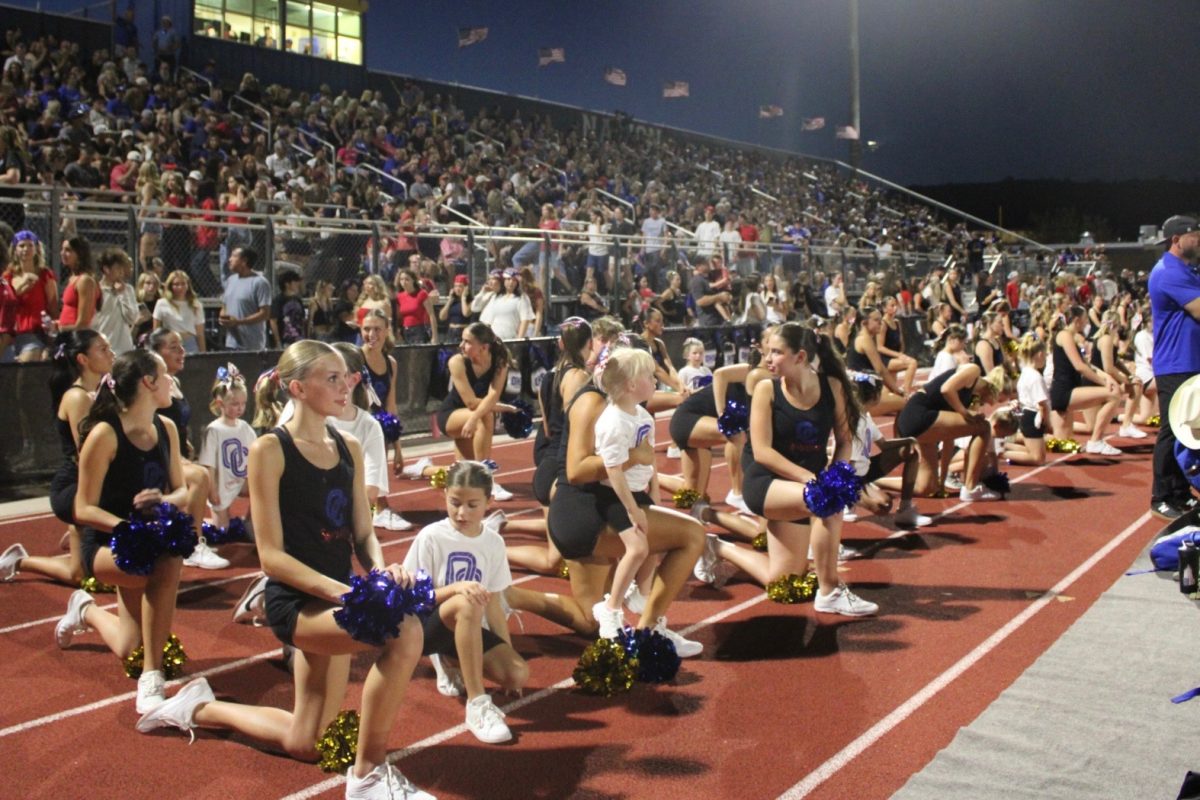One thing that OHS is known for is its great spirit lines, including pom and cheer. Pom and cheer have so many outstanding and unique things about them, yet both have very different goals and dynamics.
Whilst both being equally as important, cheer focuses more on strength and stunting with voice projection, while pom focuses on more of a dance aspect, with visuals and musicality. Both programs have a similar purpose: to hype up crowds or create energy for games.
“One of our biggest goals when we [are] learning new choreography is to make sure it is captivating enough for the people watching, sometimes, it can be really hard to captivate people without your voice and just with movements, and that’s really what pom is,” said Addyson Regnier, senior, captain of OHS pom.
One of OHS’s cheer team’s biggest aspects is tumbling. Although both have tumbling aspects, cheer has more of a stunt-focused, heavier set of tumbling skills with moves like cartwheels, back walkovers, and roundoffs, to more advanced movements such as the back handspring, standing back tuck, and layouts.
“In cheer, tumbling is one of the key aspects. I feel that, honestly, it’s one of my strongest suits and helps where I’m lacking in other places, like stunting. Another part of tumbling is being able to communicate with your body. If your body doesn’t feel the trick is right for you on the spot, you have to make up a different pathway to get to where you need to be in the routine; that’s what makes it really difficult sometimes,” said Alyssa Locicchio-Quick, sophomore.
Along with the dynamic of tumbling and cheer is the same thing with turning in Pom. The biggest aspect of pom is being able to turn together in sequence and having the correct timing. Turning can also be very difficult because if one rotation is messed up, the whole routine is now off the timing.
“Our team’s biggest thing is turns and being able to turn on time to the music. It’s something that I think I’m best at. Turns are definitely something you’re either good or not good at. It’s a toss-up, but being able to turn is one of the best things you can put out there and give to the pom team,” said Lucas Pier, junior.
The amount of teamwork necessary to be on cheer takes a lot and is only for certain personalities. One has to be able to work with others and take criticism, especially from people around them, like peers and coaches. Having teamwork is what builds a strong cheer team.
“Our cheer team takes teamwork really seriously. Having teamwork is so important to us because without teamwork our team would be a mess. Communicating through stunts and through tumbling or just communicating about us in general really helps make our team” said Londyn Jackson, sophomore.
Through ups and downs, throughout either performances or games, both of these teams have different ways of handling inconveniences.
“One of the biggest things I’ve learned while being a part of pom this year is that when something stressful is happening or something went wrong, the biggest thing we can do is talk to each other and regroup. One big thing for us is learning from each other’s mistakes and our own mistakes and just making sure the next time that they don’t happen again,” said Brielle Pursell, freshman.
Although cheer and pom are very different from each other, they also have similar aspects, one being that they perform at the games together and work as one to hype up the crowd and provide entertainment.
“We always make sure that we can hype up the crowd as much as we possibly can, and if that means working together while doing tricks and joining teams just for that purpose, we can always do that and it’s a great feeling,” Locicchio-Quick said. “It’s good to know there are other people who can help us entice more people in the crowd and bring the energy up.”
Technique is another big thing for both teams. While both teams focus on different things and different skills, both teams require a certain technique that is sometimes extremely difficult and needs years of training.
“Technique is a big thing for us. Sometimes it’s hard to remember that you still need to implement that same technique that you’ve been learning for so long into some routine that you just learned, sounds weird but sometimes you’re having so much fun that you forget that the technique is part of it all,” Pursell said.
Game nights are crucial parts of both teams’ routines. While being separate, they both get to spend time with each other during game days and build friendships across teams.
“One of my favorite things is our Friday night games. We all get to either stay at school and practice and then get ready all together or go to a different school on a bus and get ready either on the bus or together beforehand. [Anyways] we are still spending time together, and that is one of my favorite parts,” Jackson said.



